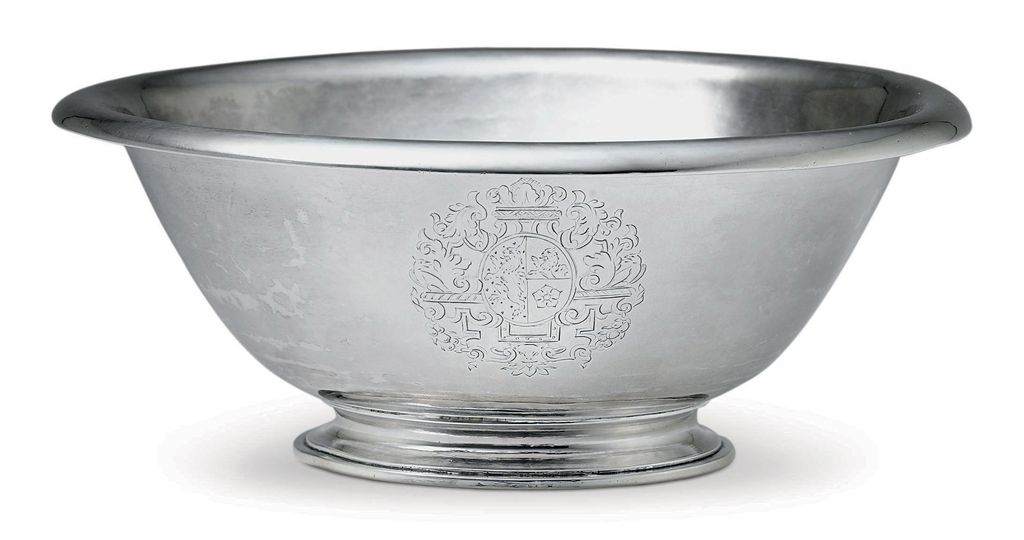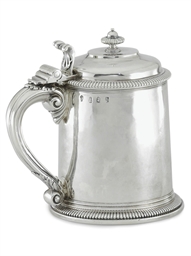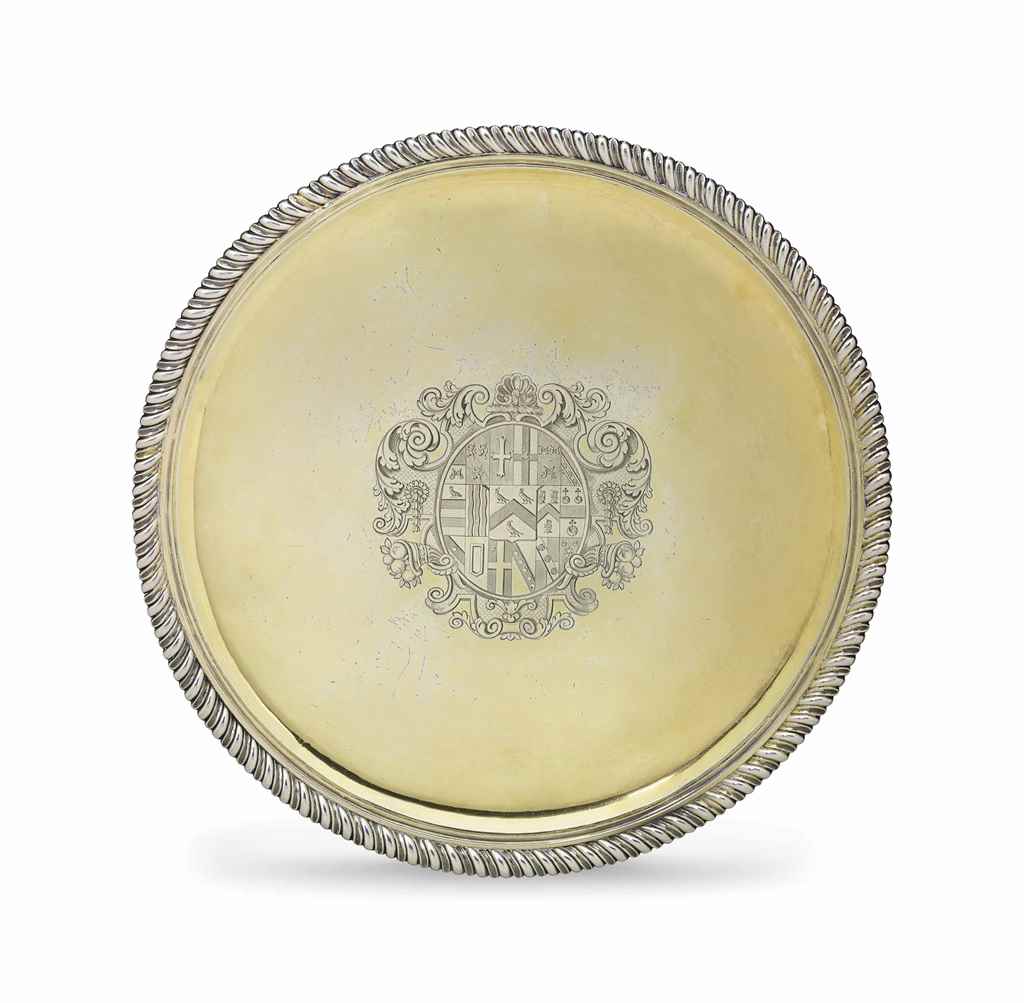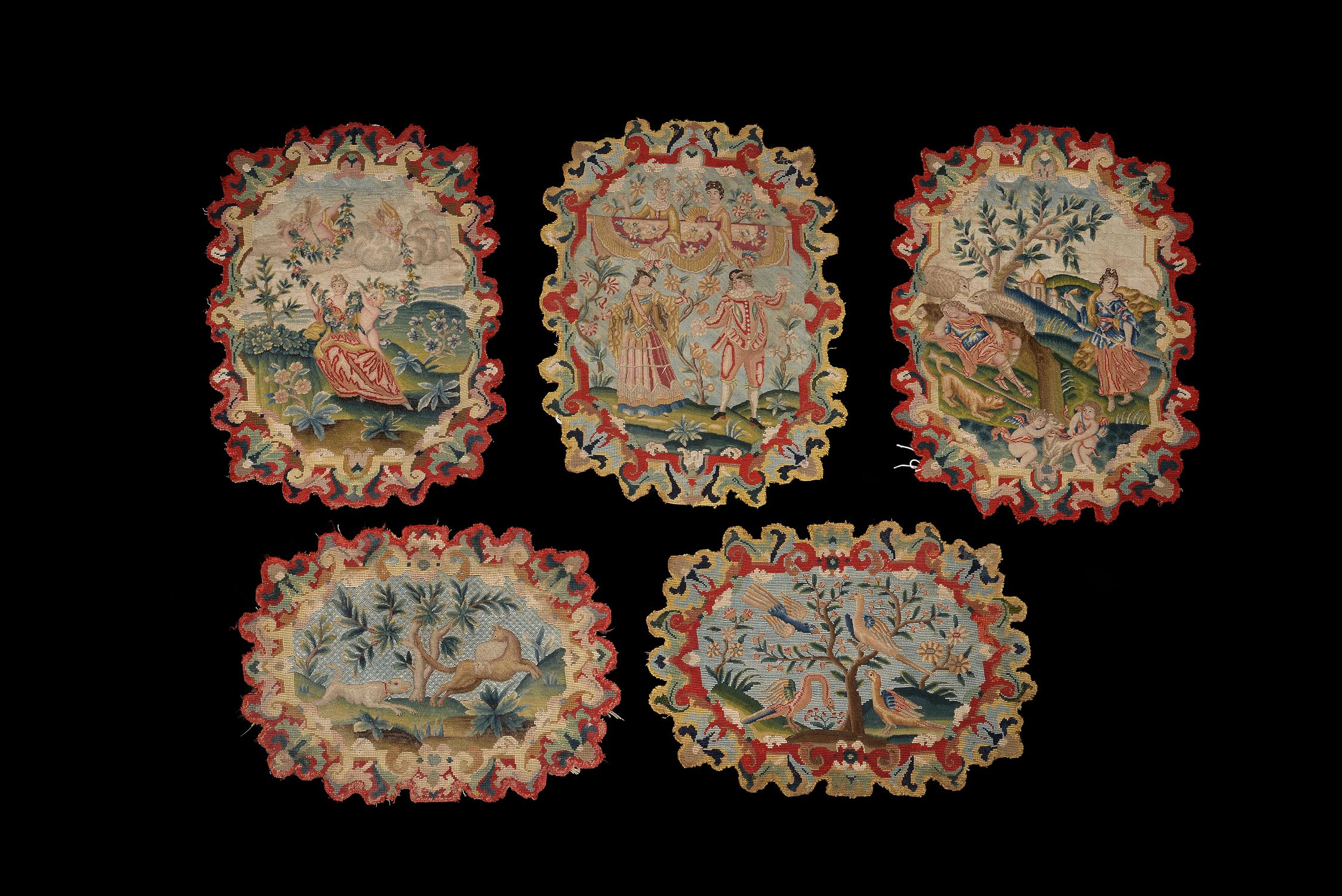Ω A fine Queen Anne gilt brass mounted ebony table clock with pull-quarter repeat Isaac Papavoine, London, circa 1705-10 The five finned pillar twin fusee movement with verge escapement regulated by short bob pendulum, pull-quarter repeat on a nest of three graduated bells and striking the hour on a further larger bell, the backplate finely engraved with symmetrical leafy scrolls and strapwork around a central crowned male mask within herringbone border, the 7 inch square brass dial with ringed winding holes and herringbone border-engraved shaped false bob aperture signed I Papauoine London to the recessed backing plate and conforming calendar aperture the finely matted centre within applied silvered Roman numeral chapter ring with sword hilt half hour markers and Arabic five minutes to outer track, with delicate pierced steel hands and winged cherub head cast spandrels to angles within herringbone engraved outer border incorporating S/N switch at nine o'clock, in a case with fine twin cherub cast handle to the bell-top superstructure and gilt urn finials, the front with raised mouldings to the glazed dial aperture flanked by scroll cast gilt escutcheon mounts, the sides with conforming rectangular glazed apertures and the rear with door matching the front set within the frame of the case, on complex moulded shallow skirt base with gilt brass claw bun feet, 39.5cm (15.5ins) high excluding handle. Provenance: Private collection, Hampshire (ref. C5); purchased at Louis Taylor and Sons, Stoke-on-Trent, 23rd March 1981 (lot 265) for £2,000 hammer. Isaac Papavoine is recorded in Loomes, Brian Clockmakers of Britain 1286-1700 as a French immigrant clockmaker who became a Free Brother of the Clockmakers’ Company in 1687/8. The only other mention of him in the Company records is a note indicating that he was much in arrears of his subscriptions in 1705/6. Loomes mentions clocks by him signed as being made in ‘Dukes Court, London’ whilst other examples inscribed ‘Suffolk Street, London’ are also known. The overall design of the current lot is typical of those made for a very short period during the formative years of the 18th century. The movement and dial are very much rooted in 17th century practice with the engraving to the backplate showing a Continental influence with strapwork and grotesques more typical of Huguenot practice. The case is surmounted by a fully developed bell-top caddy with exuberant handle which combined with a square dial very much dates the clock to around 1700 and 1710- and is of a form favoured by leading London makers such as Christopher Gould and Joseph Windmills (see Barder, Richard C. The Georgian Bracket Clock 1714-1830 for an example by Gould and Dawson, Percy G.; Drover, C.B. and Parkes, D.W. Early English Clocks 484 for a burr walnut clock by Joseph Windmills of related case design). Cites Regulations Please note that this lot (lots marked with the symbol Ω in the printed catalogue) may be subject to CITES regulations when exported from the EU. The CITES regulations may be found at www.defra.gov.uk/ahvla-en/imports-exports/cites Condition report disclaimer
Ω A fine Queen Anne gilt brass mounted ebony table clock with pull-quarter repeat Isaac Papavoine, London, circa 1705-10 The five finned pillar twin fusee movement with verge escapement regulated by short bob pendulum, pull-quarter repeat on a nest of three graduated bells and striking the hour on a further larger bell, the backplate finely engraved with symmetrical leafy scrolls and strapwork around a central crowned male mask within herringbone border, the 7 inch square brass dial with ringed winding holes and herringbone border-engraved shaped false bob aperture signed I Papauoine London to the recessed backing plate and conforming calendar aperture the finely matted centre within applied silvered Roman numeral chapter ring with sword hilt half hour markers and Arabic five minutes to outer track, with delicate pierced steel hands and winged cherub head cast spandrels to angles within herringbone engraved outer border incorporating S/N switch at nine o'clock, in a case with fine twin cherub cast handle to the bell-top superstructure and gilt urn finials, the front with raised mouldings to the glazed dial aperture flanked by scroll cast gilt escutcheon mounts, the sides with conforming rectangular glazed apertures and the rear with door matching the front set within the frame of the case, on complex moulded shallow skirt base with gilt brass claw bun feet, 39.5cm (15.5ins) high excluding handle. Provenance: Private collection, Hampshire (ref. C5); purchased at Louis Taylor and Sons, Stoke-on-Trent, 23rd March 1981 (lot 265) for £2,000 hammer. Isaac Papavoine is recorded in Loomes, Brian Clockmakers of Britain 1286-1700 as a French immigrant clockmaker who became a Free Brother of the Clockmakers’ Company in 1687/8. The only other mention of him in the Company records is a note indicating that he was much in arrears of his subscriptions in 1705/6. Loomes mentions clocks by him signed as being made in ‘Dukes Court, London’ whilst other examples inscribed ‘Suffolk Street, London’ are also known. The overall design of the current lot is typical of those made for a very short period during the formative years of the 18th century. The movement and dial are very much rooted in 17th century practice with the engraving to the backplate showing a Continental influence with strapwork and grotesques more typical of Huguenot practice. The case is surmounted by a fully developed bell-top caddy with exuberant handle which combined with a square dial very much dates the clock to around 1700 and 1710- and is of a form favoured by leading London makers such as Christopher Gould and Joseph Windmills (see Barder, Richard C. The Georgian Bracket Clock 1714-1830 for an example by Gould and Dawson, Percy G.; Drover, C.B. and Parkes, D.W. Early English Clocks 484 for a burr walnut clock by Joseph Windmills of related case design). Cites Regulations Please note that this lot (lots marked with the symbol Ω in the printed catalogue) may be subject to CITES regulations when exported from the EU. The CITES regulations may be found at www.defra.gov.uk/ahvla-en/imports-exports/cites Condition report disclaimer















Try LotSearch and its premium features for 7 days - without any costs!
Be notified automatically about new items in upcoming auctions.
Create an alert